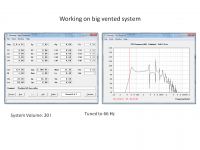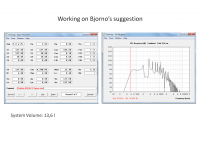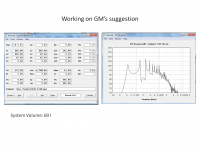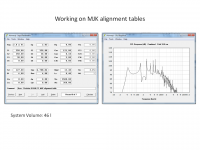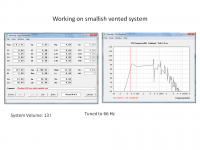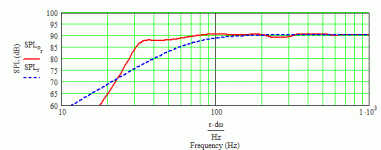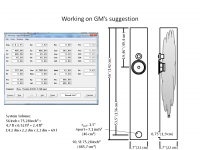Hi Forum
I would like to get some input on a speaker I am considering.
I wish to make a floorstanding unit for my living room (45m2 ~485 sq ft). I will be driving the speakers from a Music Hall a15.2 amp. My music taste is in the 'popish' area, such as: Paramore, Katy Perry, Kelly Clarkson, Therapy? and Massive Attack (the 5 last acts I have heard).
I have used the TQWPmetric excel sheet by John Rutter for doing calculations of the enclosure.
I already have a Monacor Predator which I want to use, the main characteristics are:
Fs: 66 Hz
Qts: 0.41
Vas: 10.6 l
Sd: 127 cm2
Xmax: +/- 3.75 mm
SPL: 91 dB (1m, 1W)
I plan on adding a Wavecor tweeter on top of the main cabinet and use a simple passive 2nd order Linkwitz-Riley filter at 2500 Hz to take care of the highs, but that is not the most important issue right now.
When plugging in the numbers for the Monacor unit in the excel sheet, I get a design with a volume of 24.5 l and a very narrow front of 146 mm (internal).
I notice that John Rutter mentions that the design cannot be expected to be good, but only provide a starting point - but what should I expect to tweak in the design, is it pretty much everything: Internal baffle length, mouth size, cabinet volume or is it smaller things like damping and electric filter?
Am I missing something here? is there any chance I will be happy about putting the Predator in a TQWP?
---
Disclaimer: I know this is strictly speaking a multi-way speaker but posters in this forum seem much more interested in transmissionlines/horns etc. than anywhere else, so I will stick my neck out .
.
- Anders
I would like to get some input on a speaker I am considering.
I wish to make a floorstanding unit for my living room (45m2 ~485 sq ft). I will be driving the speakers from a Music Hall a15.2 amp. My music taste is in the 'popish' area, such as: Paramore, Katy Perry, Kelly Clarkson, Therapy? and Massive Attack (the 5 last acts I have heard).
I have used the TQWPmetric excel sheet by John Rutter for doing calculations of the enclosure.
I already have a Monacor Predator which I want to use, the main characteristics are:
Fs: 66 Hz
Qts: 0.41
Vas: 10.6 l
Sd: 127 cm2
Xmax: +/- 3.75 mm
SPL: 91 dB (1m, 1W)
I plan on adding a Wavecor tweeter on top of the main cabinet and use a simple passive 2nd order Linkwitz-Riley filter at 2500 Hz to take care of the highs, but that is not the most important issue right now.
When plugging in the numbers for the Monacor unit in the excel sheet, I get a design with a volume of 24.5 l and a very narrow front of 146 mm (internal).
I notice that John Rutter mentions that the design cannot be expected to be good, but only provide a starting point - but what should I expect to tweak in the design, is it pretty much everything: Internal baffle length, mouth size, cabinet volume or is it smaller things like damping and electric filter?
Am I missing something here? is there any chance I will be happy about putting the Predator in a TQWP?
---
Disclaimer: I know this is strictly speaking a multi-way speaker but posters in this forum seem much more interested in transmissionlines/horns etc. than anywhere else, so I will stick my neck out
- Anders
Hi Forum
I would like to get some input on a speaker I am considering.
I wish to make a floorstanding unit for my living room (45m2 ~485 sq ft). I will be driving the speakers from a Music Hall a15.2 amp. My music taste is in the 'popish' area, such as: Paramore, Katy Perry, Kelly Clarkson, Therapy? and Massive Attack (the 5 last acts I have heard).
I have used the TQWPmetric excel sheet by John Rutter for doing calculations of the enclosure.
I already have a Monacor Predator which I want to use, the main characteristics are:
Fs: 66 Hz
Qts: 0.41
Vas: 10.6 l
Sd: 127 cm2
Xmax: +/- 3.75 mm
SPL: 91 dB (1m, 1W)
I plan on adding a Wavecor tweeter on top of the main cabinet and use a simple passive 2nd order Linkwitz-Riley filter at 2500 Hz to take care of the highs, but that is not the most important issue right now.
When plugging in the numbers for the Monacor unit in the excel sheet, I get a design with a volume of 24.5 l and a very narrow front of 146 mm (internal).
I notice that John Rutter mentions that the design cannot be expected to be good, but only provide a starting point - but what should I expect to tweak in the design, is it pretty much everything: Internal baffle length, mouth size, cabinet volume or is it smaller things like damping and electric filter?
Am I missing something here? is there any chance I will be happy about putting the Predator in a TQWP?
---
Disclaimer: I know this is strictly speaking a multi-way speaker but posters in this forum seem much more interested in transmissionlines/horns etc. than anywhere else, so I will stick my neck out.
- Anders
Hi Anders,
:2: observations:
Nice tweeter choice, should work well but you have to reconsider 24.5 L for a TQWT or a TQWP. IMO the suggested worksheet is not a tool a serious designer would ever use.
A xmax at 3.75 mm for a mid-bass(Predator) in a room of 45 m^2 built in a tower and HP restricted below ~80 Hz in a TQWT/TQWP or in a QWP can at max deal with an input power of~32W /_~107 dB/1m/1W if XO:d to a sub covering ~80 Hz.
You can calculate the SPL-max at a listening distance of 2.5 m to: L2=10lg((r1)^2/(r2)^2)+L1;
L2=10lg((1)^2/(2.5)^2)+107; = ~-7.96-107= ~99 dB and with at least a 3 dB margin gives a maximum level of ~96 dB.
But first calculate the needed volume for the driver in a QWP (As being a straight pipe with constant CSA_Cross-Sectional-Area it's ways larger than the volume needed for a TQWT aka TQWP who both have a Rec. Sd/3 terminus area) :, i.e. restrict Volume=Vb to max. 2 x Vas or to an equivalent Qt for the driver in box to Qt=~0.5(closed terminus).
If Vb= 2*Vas ==> Qt= Qts x sqrt(1+Vas/Vb) = Qts x sqrt(1.5) = 0.413==> Qt= 0.502; Vb max. = 2 x 10.6= 21.2L and as any TQWP/TQWT must incorporated with stuffing materials with a min. density of~3.2kg/m^3 or ~ 50 gram for the QWP(Last ¼ x pipe-length is left without damping) and ~ 40 gram for an TQWT/TQWP.
If the driver is placed at ~a third of the pipe/tube length(IME preferred) and the Area at the closed end is ~= Driver Sd then the internal enclosure height would be min. 35 cm, i.e. this enclosure* needs a stand below for a proper listening height.
Placing the driver at the closed end (or near)is not recommended since the ripple would be high and if tamed the f-3dB would not be lower than ~100Hz. An example : Pipe length for a QWP would be ~105 cm at max
Calculate a maximum length using 2 x Vas and CSA=Sd will result of a pipe length of ~167 cm(minimum~56 cm tall, internal height) but the FR would sag towards lover frequencies (f-3dB= ~43 Hz at an expense of a ~ 8 dB lower SPL. This is IMO not Rec. as at 2.5 m listening distance only 91 dB is max SPL.
* IMO the only way to make a tower where the driver is near listening height is to design a slim ML-TL using a Vb=~12.6L (internal box depth=~10 cm) tuned lowest to ~55Hz giving a f-3dB= ~ 50 Hz.
b
Hi Bjorno
Thanks for your input. I am working a bit on your suggestion of a straight pipe ML-TL. I am trying to decipher Martin Kings alignment tables combined with some of Dave's (Planet10) designs to see if I can make more sense of things.I will get back with some drawings later.
I do not yet understand your comment regarding a maximum volume of 2Vas, I do understand that for a closed box with minimum resonance that will equal a system Q of 0.5 but I am uncertain how that relates to a transmission line and even less how that relates to a ported transmission line.
When I use WINisd I get a fairly useful (untrained eye) ported simulation with a Vb of 18 l and tuning of the port to 65 Hz. I get f3 at 57 Hz and a output peak at 73 Hz of about 1.2 dB.
- Anders
Thanks for your input. I am working a bit on your suggestion of a straight pipe ML-TL. I am trying to decipher Martin Kings alignment tables combined with some of Dave's (Planet10) designs to see if I can make more sense of things.I will get back with some drawings later.
I do not yet understand your comment regarding a maximum volume of 2Vas, I do understand that for a closed box with minimum resonance that will equal a system Q of 0.5 but I am uncertain how that relates to a transmission line and even less how that relates to a ported transmission line.
When I use WINisd I get a fairly useful (untrained eye) ported simulation with a Vb of 18 l and tuning of the port to 65 Hz. I get f3 at 57 Hz and a output peak at 73 Hz of about 1.2 dB.
- Anders
Hi Bjorno
Thanks for your input. I am working a bit on your suggestion of a straight pipe ML-TL. I am trying to decipher Martin Kings alignment tables combined with some of Dave's (Planet10) designs to see if I can make more sense of things.I will get back with some drawings later.
I do not yet understand your comment regarding a maximum volume of 2Vas, I do understand that for a closed box with minimum resonance that will equal a system Q of 0.5 but I am uncertain how that relates to a transmission line and even less how that relates to a ported transmission line.
When I use WINisd I get a fairly useful (untrained eye) ported simulation with a Vb of 18 l and tuning of the port to 65 Hz. I get f3 at 57 Hz and a output peak at 73 Hz of about 1.2 dB.
- Anders
use hornresp if you're dealing with horn type speakers, makes things a lot easier to understand i found than a wall of writing.
Taking a somewhat different approach to get down to ~40 Hz, designing a MLTL with a net Vb tuned to Fs based on an Av = Sd x 0.75” long equates to ~2.44 ft^3, then tuning it a bit lower to even better damp it and to account for some boundary loading and/or a bit of BSC to flatten it……..
39 Hz Fb MLTL
L = 56”
zdriver = 19.46”
zport = 53.5”
S0, SL = 75.28”^2
Density = 0.35 lbs/ft^3
Rport = 1.5”
Lport = .75”
All dims i.d. and approximate.
GM
39 Hz Fb MLTL
L = 56”
zdriver = 19.46”
zport = 53.5”
S0, SL = 75.28”^2
Density = 0.35 lbs/ft^3
Rport = 1.5”
Lport = .75”
All dims i.d. and approximate.
GM
Done some sims
Thank you very much for your suggestions. I have been playing a bit with hornresp these past couple of evenings. I think I have understood some of it, although I have still to figure out if I can incorporate the driver and port placement further into the simulation. Because of the driver placement issue I do not worry too much about the third harmonic of the pipe designs. I also do not worry about the highfrequency roll-off, I figure it has something to do with the speaker impedance and choose not to focus on that.
I have made a series of different simulations with versions of both Bjorno's and GM's suggestions (as I have understood them) as well as a sim of the result I got from MJK's alignment table and then two vented boxes (all are attached).
I like the flattness and level of the Bjorno sim, but I am not thrilled about the trough between 200 and 400 Hz.
The two large enclosure pipe designs GM, MJK suffer from the same trough between 200 and 400 Hz and additionally a quite low SPL below 200 apart from the peak around 45 Hz. Overall I am tempted to say that they look like horrible responses.
The two traditional vented boxes have SPL curves more like I would expect them, though the peak for the smallish box around resonance is a bit larger than I had expected. The smallish design resembles a speaker I have already assembled with the Predator and another tweeter.
What do you think. Am I doing the simulations somewhat correct, and do I worry too much about the 200-400 Hz trough on the pipe designs?
Best
Anders
Thank you very much for your suggestions. I have been playing a bit with hornresp these past couple of evenings. I think I have understood some of it, although I have still to figure out if I can incorporate the driver and port placement further into the simulation. Because of the driver placement issue I do not worry too much about the third harmonic of the pipe designs. I also do not worry about the highfrequency roll-off, I figure it has something to do with the speaker impedance and choose not to focus on that.
I have made a series of different simulations with versions of both Bjorno's and GM's suggestions (as I have understood them) as well as a sim of the result I got from MJK's alignment table and then two vented boxes (all are attached).
I like the flattness and level of the Bjorno sim, but I am not thrilled about the trough between 200 and 400 Hz.
The two large enclosure pipe designs GM, MJK suffer from the same trough between 200 and 400 Hz and additionally a quite low SPL below 200 apart from the peak around 45 Hz. Overall I am tempted to say that they look like horrible responses.
The two traditional vented boxes have SPL curves more like I would expect them, though the peak for the smallish box around resonance is a bit larger than I had expected. The smallish design resembles a speaker I have already assembled with the Predator and another tweeter.
What do you think. Am I doing the simulations somewhat correct, and do I worry too much about the 200-400 Hz trough on the pipe designs?
Best
Anders
Attachments
You’re welcome!
Hmm, I thought I attached the sim. Oh well, better late than never.
Regardless, HR is programmed with absolutes and has no damping or alternate vent positioning, so can look pretty horrible if you don’t know how to interpret them. For instance, your best looking sim will be much more rolled off in reality unless you like listening to cabs with no internal damping.
For more accurate sims you must use MJK’s software or AkAbak [there may be others also].
Note too that these 2 pi [half space] sims are only ~100% accurate if the speaker is buried flush in the ground of a very large, empty, field with the mic suspended overhead, so not only will the room and the speaker’s position in it change the response, but often some form of EQ is required to flatten them out.
Sorry, don’t have time right now to check your sims.
Anyway, as you can see, the MJK sim looks nothing like HR’s and enough real world measurements have proven them to be plenty accurate enough.
GM
Hmm, I thought I attached the sim. Oh well, better late than never.
Regardless, HR is programmed with absolutes and has no damping or alternate vent positioning, so can look pretty horrible if you don’t know how to interpret them. For instance, your best looking sim will be much more rolled off in reality unless you like listening to cabs with no internal damping.
For more accurate sims you must use MJK’s software or AkAbak [there may be others also].
Note too that these 2 pi [half space] sims are only ~100% accurate if the speaker is buried flush in the ground of a very large, empty, field with the mic suspended overhead, so not only will the room and the speaker’s position in it change the response, but often some form of EQ is required to flatten them out.
Sorry, don’t have time right now to check your sims.
Anyway, as you can see, the MJK sim looks nothing like HR’s and enough real world measurements have proven them to be plenty accurate enough.
GM
Attachments
...snip...
Anyway, as you can see, the MJK sim looks nothing like HR’s and enough real world measurements have proven them to be plenty accurate enough.
GM
Sounds very good. As you might be able to tell, I really like your dimensions on the speaker a lot.
Just to be sure though, I have made a sketch, because time and again I have made mistakes in assumptions - is the sketch what you had in mind?
I also realized I only considered the peak going up of the 3rd harmonic, not the dip... You are right that it will take some practice to interpret the simulation.
Attachments
I am trying to decipher Martin Kings alignment tables combined with some of Dave's (Planet10) designs
Anders,
None of the TL designs i have drawn are my designs. Usually Scott's, but GM, Griffin and others too.
dave
PS: i'm moving this thread to the multi-way forum, it is not a full-range.
You have a bit of mismatch between the two drivers so you're going to have to put a shelving network in the tweeter branch. Btw, TQWP's are fantastic speakers but 6.5 inch would be the best size.
Mac
http://www.diyaudio.com/forums/vendors-bazaar/215967-diy-loudspeaker-construction.html
Mac
http://www.diyaudio.com/forums/vendors-bazaar/215967-diy-loudspeaker-construction.html
- Status
- This old topic is closed. If you want to reopen this topic, contact a moderator using the "Report Post" button.
- Home
- Loudspeakers
- Multi-Way
- TQWP/TQWT with kickbass unit
